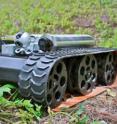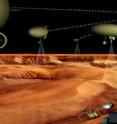Planetary exploration robots to be featured on science program 'WaveLengths'
Related images
(click to enlarge)
A University of Arizona College of Engineering researcher and his team who are developing intelligent robots for planetary exploration will be featured in a segment of an upcoming episode of the science program "WaveLengths." The robots will be featured on the episode premiering Thursday night, February 24 at 8:30 p.m. MST on public television KUAT Channel 6. "WaveLengths" is a quarterly science program hosted by BIO5 Institute Member Dr. Vicki Chandler.
The exploration robots are part of a tier-scalable, reconnaissance system prototype which would be used for planetary exploration. A team lead by Prof. Wolfgang Fink of the Department of Electrical and Computer Engineering at the UA College of Engineering developed the reconnaissance system, involving an orbiting satellite, overhead blimp, and surface level, autonomous surface rovers and sea rovers. The intelligent, free-thinking rovers would have the ability to target specific exploration areas for sample and data acquisition.
Communication between the three tiers would take just seconds instead of hours, and the satellite at the top of the tiers would be calling the shots.
The planetary exploration rovers and sea rovers generated industry excitement in November 2010 during opening exhibitions at the international MacTech conference in Los Angeles, when developers received their first public glimpse of the functionality of the Mac-based robotic platforms outside of a university or research setting.
UA Engineering's Prof. Fink is one of only a few dozen researchers who are developing robots with true high-level independence that enables them to avoid danger while investigating specific planetary features. The rovers -- which can carry payloads of 60 pounds -- are based on Mac minis and controlled by iOS devices such as the iPod Touch or iPhone. A sea exploration rover, also controllable by iOS devices, will also be featured on the Feb. 24 "WaveLengths" program.
Source: University of Arizona College of Engineering
Other sources
- Planetary exploration robots to be featured on science program ‘WaveLengths’from Science BlogFri, 18 Feb 2011, 15:31:25 UTC
- Planetary exploration robots to be featured on science program 'WaveLengths'from PhysorgFri, 18 Feb 2011, 15:01:07 UTC


